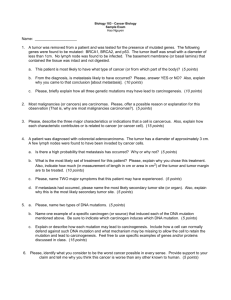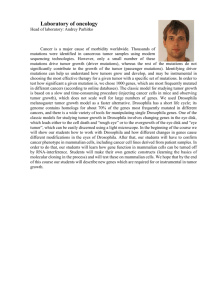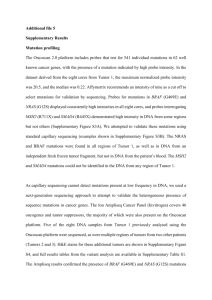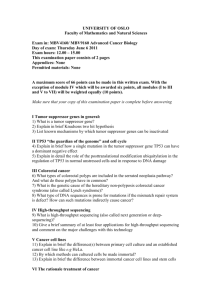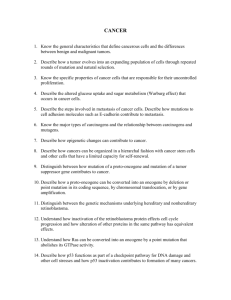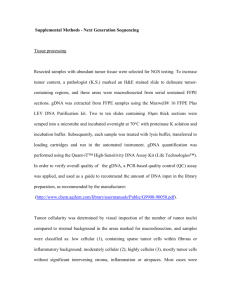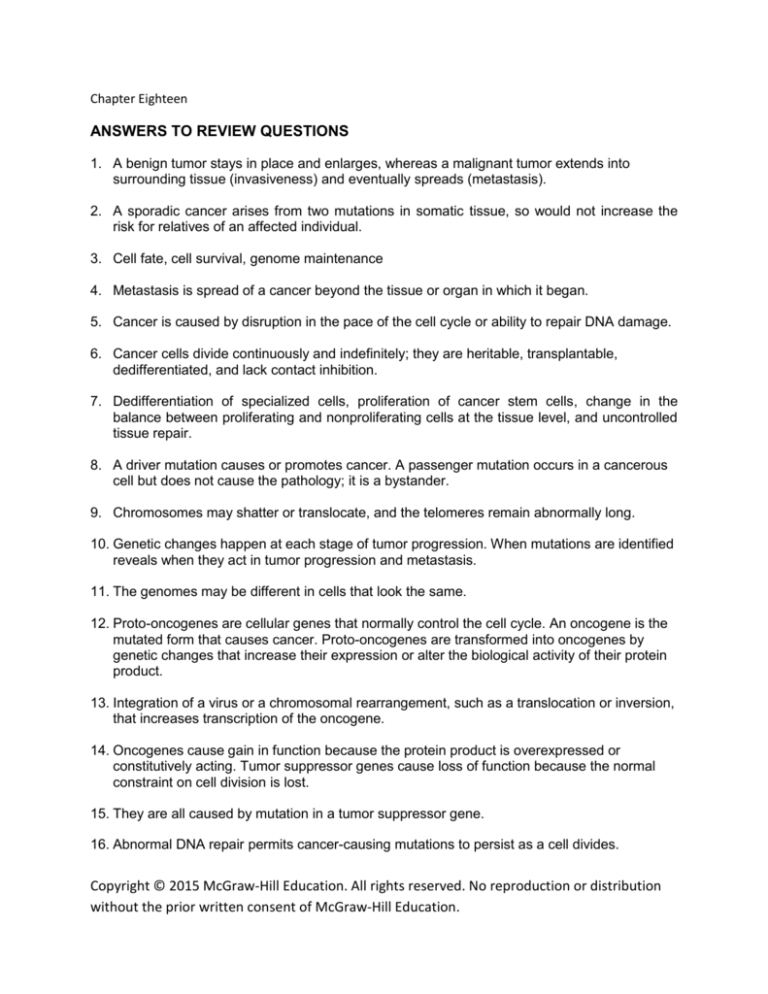
Chapter Eighteen
ANSWERS TO REVIEW QUESTIONS
1. A benign tumor stays in place and enlarges, whereas a malignant tumor extends into
surrounding tissue (invasiveness) and eventually spreads (metastasis).
2. A sporadic cancer arises from two mutations in somatic tissue, so would not increase the
risk for relatives of an affected individual.
3. Cell fate, cell survival, genome maintenance
4. Metastasis is spread of a cancer beyond the tissue or organ in which it began.
5. Cancer is caused by disruption in the pace of the cell cycle or ability to repair DNA damage.
6. Cancer cells divide continuously and indefinitely; they are heritable, transplantable,
dedifferentiated, and lack contact inhibition.
7. Dedifferentiation of specialized cells, proliferation of cancer stem cells, change in the
balance between proliferating and nonproliferating cells at the tissue level, and uncontrolled
tissue repair.
8. A driver mutation causes or promotes cancer. A passenger mutation occurs in a cancerous
cell but does not cause the pathology; it is a bystander.
9. Chromosomes may shatter or translocate, and the telomeres remain abnormally long.
10. Genetic changes happen at each stage of tumor progression. When mutations are identified
reveals when they act in tumor progression and metastasis.
11. The genomes may be different in cells that look the same.
12. Proto-oncogenes are cellular genes that normally control the cell cycle. An oncogene is the
mutated form that causes cancer. Proto-oncogenes are transformed into oncogenes by
genetic changes that increase their expression or alter the biological activity of their protein
product.
13. Integration of a virus or a chromosomal rearrangement, such as a translocation or inversion,
that increases transcription of the oncogene.
14. Oncogenes cause gain in function because the protein product is overexpressed or
constitutively acting. Tumor suppressor genes cause loss of function because the normal
constraint on cell division is lost.
15. They are all caused by mutation in a tumor suppressor gene.
16. Abnormal DNA repair permits cancer-causing mutations to persist as a cell divides.
Copyright © 2015 McGraw-Hill Education. All rights reserved. No reproduction or distribution
without the prior written consent of McGraw-Hill Education.
17. FAP colon cancer revealed that cancers progress in stages.
18. Mutations are changes to the genotype. Altered gene expression affects transcription and
translation. Epigenetic changes affect which genes are silenced in specific cell types under
specific conditions.
19. Several different combinations of mutations may contribute to the development of cancer in
the same cell type. Each may have a different response to treatment.
20. Liquid biopsy (test cancer cells in a person’s blood).
ANSWERS TO APPLIED QUESTIONS
1. Retinoblastoma.
2. Gleevec binds and blocks specific proteins inside a cell. Herceptin binds and blocks a cell
surface receptor called HER2.
3. Several drugs target different mutations that drive a cancer.
4. It is an oncogene because it caused overexpression of a transcription factor.
5. BRCA2 is a tumor suppressor gene important for DNA repair in multiple tissues.
6. A virus can cause cancer by altering a promoter region, inducing a translocation, causing
insertional mutagenesis, or altering immune function.
7. The cells from the original tumor are not genetically identical.
8. Treatment for leukemia is more complex than removal of a solid organ because bone
marrow must be replaced.
9. Incorrect. Cancer takes a long time to develop—recent dietary changes are not responsible.
10. Today a woman with metastatic breast cancer would have genetic tests that could predict
which drugs her cancer cells are likely to be sensitive to.
11. No. Cancer cells have telomeres that are too long, not too short.
ANSWERS TO WEB ACTIVITIES
1. a. Poor prognosis, public health impact, tissue from the cancer and healthy parts
from the same patient, consent, high quality, and enough tissue
b. Opinion—perhaps a rare cancer with little interest and no treatments, or the
opposite, a cancer that affects many people and treatments are inadequate
c. The sequence of mutations that drive the cancer.
d. Which drugs are more likely to work with the fewest or no adverse effects?
Copyright © 2015 McGraw-Hill Education. All rights reserved. No reproduction or distribution
without the prior written consent of McGraw-Hill Education.
e. A cancer changes genetically over time.
2. myc is a transcription factor. Src is a tyrosine kinase. APC is a tumor suppressor that causes
the increased cell division rate that leads to a polyp.
3. Herceptin blocks human epidermal growth factor binding. Gleevec is discussed in the
chapter introduction. It blocks a tyrosine kinase. Avastin is an angiogenesis inhibitor.
ANSWERS TO CASE STUDIES AND RESEARCH RESULTS
1. a. The tumor suppressor form of RB, because it is due to a germline mutation that
confers initial susceptibility. Siblings could have inherited the same germline
mutation.
b. Surgical removal of one eye makes sense for MYCN RB because the second
eye will not be affected. See http://blogs.plos.org/dnascience/2013/03/21/second-genecauses-retinoblastoma/ for a fuller explanation.
2. Chromosomes in affected cells remain too long. The telomeres do not shrink as they should
over time.
3. Each mutation combination must be evaluated for success of different treatments, and
treatment success must be compared for selection based on genetics versus the older
histological method.
4. Gene expression analysis or mutational analysis
5. Stopping the drug allowed some cancer cells to escape that have mutations in genes other
than the one that initially caused the cancer.
6. Patient 4 is further along in the illness than patient 3, and patient 3 is further along than
patient 1. Patient 2 is at the beginning.
7. She could have a familial cancer syndrome.
Copyright © 2015 McGraw-Hill Education. All rights reserved. No reproduction or distribution
without the prior written consent of McGraw-Hill Education.

